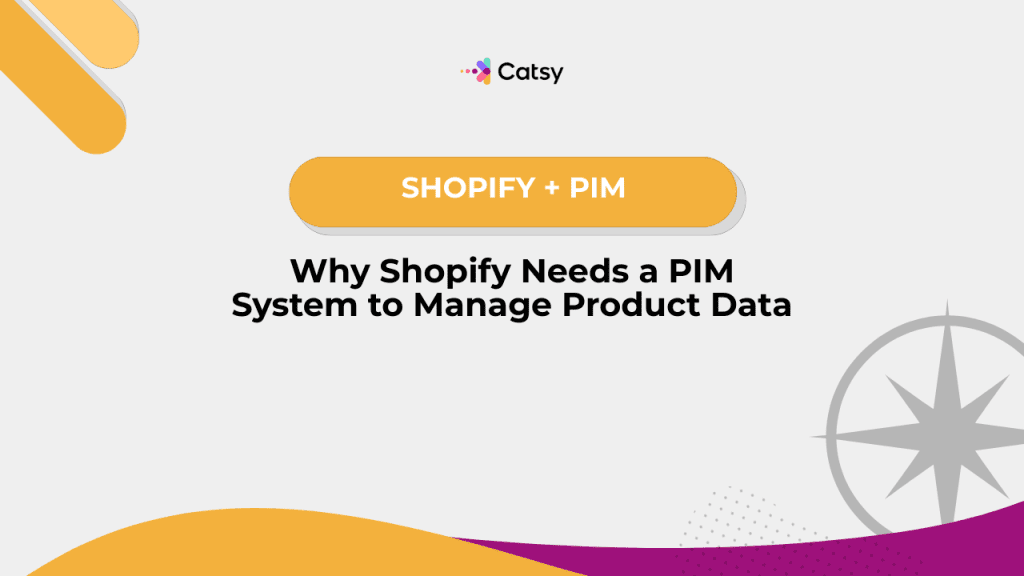
Chart Your Course
- Shopify Product Data: A Quick Overview
- Why Shopify-Only Data Management Fails
- Top 3 Tips: How to Navigate Product Data with Catsy PIM
- Real Examples and Key Takeaways
What You Will Learn
- Why Shopify alone isn’t enough for scaling product data management
- How Catsy PIM eliminates manual effort and scattered workflows
- Practical strategies to centralize, optimize, and automate your product content
- Real-world results from brands who transformed their Shopify operations with Catsy
In this Article
1. Shopify Product Data: A Quick Overview
As you set sail on the seas of e-commerce, Shopify is one of the best ships to board. It’s user-friendly, it’s fast to launch, and it offers a deep harbor of integrations that make it easy to get started.
But there’s a navigational challenge: Shopify wasn’t built for heavy cargo. Once your product catalog grows beyond basic retail needs, you’re left patching sails and bailing water just to stay afloat.
Managing product data in Shopify quickly becomes a storm of meta fields, CSV uploads, and made-as-you-go workarounds that aren’t sustainable.
That’s where a Product Information Management (PIM) system for Shopify like Catsy comes in. Your PIM helps you centralize, enrich, and command your content across each of your channels. You can sail smoothly, even in the high seas of complexity.
a. The Foundation of Effective Product Management
With Catsy’s PIM, Shopify merchants gain a central command bridge for product specs, digital assets, and SEO fields! Rather than manually duplicate each effort across sales channels, PIM transforms data into a coordinated crew.
Centralized Command and Control
A sophisticated PIM will serve as your operational headquarters. Here, all your data is created, validated, and distributed to your channels. This eliminates the chaos of scattered files and spreadsheets across multiple teams.
This unified approach ensures that your data quality is consistent across each of your touchpoints… all while enabling collaboration. Marketing, product management, and tech teams can work with the same accurate info regardless of their specific role in your company.
Automated Content Distribution
Instead of manual updates, PIM systems are automatic. Content syndication ensures accuracy and consistency, no matter where your customers find you. Changes made within your central system will propagate automatically to each of your channels. This is based on predefined rules and mappings.
b. Scaling Beyond Basic Retail Operations
As your business grows, Shopify’s limitations become more apparent.
Complex product lines, global operations, and multi-channel strategies require more sophisticated data management than basic e-commerce platforms can offer.
Complex Product Hierarchies
Advanced product lines involve intricate relationships between parent products, variants, accessories, and related items. These relationships require organization – a systematic approach that supports the optimization of both your operations and your customer experience.
Using traditional approach, you may struggle with complex matrices, cross-sells, and tech specs. PIM systems excel at managing these for you while maintaining accuracy and simplicity.
Multi-Channel Content Strategy
Modern businesses operate across multiple sales channels. Unfortunately, these channels each have specific requirements and consumer expectations. For instance, Amazon listings need different content than a direct-to-consumer store. Meanwhile, business-to-business portals require detailed specs that consumer platforms may not emphasize.
Make Catsy DAM and PIM Software an Extension of Your Team
Book a Free Demo2. Why Shopify-Only Data Management Fails
a. Shopify Isn’t a PIM: Platform Limitations
Shopify excels as a storefront and a transaction processing platform. It wasn’t designed to be a comprehensive product information management system.
Shopify can’t handle deep hierarchies, complex variants, or sophisticated localization. And attempting enterprise-level workflow governance is like trying to navigate over seas with equipment designed for the lake.
Structural Limitations
Shopify’s database structure prioritizes transaction efficiency, not complex relationship management. While this his great for a wonderful checkout experience, it creates challenges for businesses with complex catalogs.
Metafield management is unwieldy at scale, lacking the validation rules, inheritance hierarchies, and workflow controls that professional product management requires. Each product will need individual attention.
Scalability Constraints
As your product catalog grows, native Shopify tools may not be able to keep up. Efficiency and accuracy may fall, and manual processes become overwhelming when you begin to manage hundreds or thousands of SKUs.
The Shopify platform lacks sophisticated batch operations, validation rules, and quality control mechanisms that can prevent errors from reaching customer-facing channels.
b. Manual Chaos and Redundancy: Operational Inefficiency
Managing product data through spreadsheets or fragmented app plugins is like patching your sails with duct tape. It’ll work in a pinch, but it’s not efficient, and it’s quite risky! Human errors inevitably creep in, and there’s no reliable version control.
Error-Prone Manual Processes
Repetitive manual data entry introduces opportunities for error at each step. Specs may get transcribed incorrectly, images may be incorrectly assigned, or pricing may become inconsistent across your channels.
These errors compound over time, creating customer confusion, returns, and support issues that will damage your brand’s reputation and your operational efficiency.
Resource Drain and Inefficiency
As your catalog grows, team members will begin to spend a lot more time on administrative tasks – they’re no longer available to drive business growth. Content creation, optimization, and analysis may take a back seat to basic data maintenance.
Version Control Chaos
Without centralized version control, team members will be working with varying versions of the same information. This, of course, creates conflicts and inconsistencies. An update made in one system won’t propagate to others, and this leads to customer confusion.
c. SEO and Channel Constraints: Limited Optimization Capabilities
Shopify offers basic SEO fields a few customization options, but when it comes to channel-specific data or multi-market optimization, it’s quite limited. Your team will end up making manual adjustments each time market conditions change.
SEO Optimization Limitations
Native Shopify SEO tools lack the tools needed for competitive search performance. Template-driven optimization, automated meta descriptions, and systematic keyword integration require external solutions.
Advanced SEO strategies like structured data markup, rich snippets optimization, and technical SEO coordination across product families are more examples of requirements that can’t be fulfilled with native capabilities.
Multi-Channel Metadata Management
Different sales channels require different content approaches.For instance, Google Shopping feeds need specific attributes, Amazon listings require different keyword emphasis, and business-to-business portals need technical specification highlights.
d. Growth Horizon Limitations: Scaling Constraints
If you don’t have a central PIM system, expansion to new channels, new regions, or new customer segments becomes overwhelming. Launching on Amazon or adding multilingual support requires a lot more time – and it introduces risk.
Channel Expansion Complexity
Each new sales channel introduces unique requirements for product information, tech specifications, and content optimization. Without a systematic approach, channel expansion becomes a custom project … not a strategic growth process.
International Market Entry
Global expansion requires much more than simple translation! Regional compliance requirements, cultural preferences, and local business practices need systematic accommodation.
3. Top 3 Tips: How to Navigate Product Data with Catsy PIM
a. Centralize All Product Content: Establishing Your Command Center
With Catsy, you create a single source of truth for all product-related information. Your titles, specs, media assets, and more is all docked in one organized and accessible hub. Rather than searching through chaotic spreadsheets and databases, your whole team can access one clear, accurate command center.
Unified Information Architecture
Built-in validation rules and approval workflows ensure that every piece of product content meets your established standards before your information goes live. This quality control prevents errors and keeps your teams efficient.
Consistent data structures across your catalog enable powerful automation and batch operations. Similar products will benefit from shared templates and rules, which dramatically reduces manual effort.
Collaborative Content Creation
With PIM, multiple teams can work on related product information – no more waiting for emails or cloud documents! Real-time collab features simply the process, giving everyone current, accurate data. Responsibility boundaries can also be set.
Version control and change tracking provide complete audit trails for all of your product information modifications. Teams can understand who made changes, when they occurred, and why each of these decisions were made.
b. Optimize SEO & Metadata at Scale: Rigging Your Sales for Maximum Performance
Think of metadata as your vessel’s sails. Well-rigged content just sails better.
Quality content catches more traffic and converts browsers into buyers. Catsy allows you to standardize and optimize your SEO fields like alt text and structured data with precision.
Template-Driven SEO Optimization
Rather than manually crafting SEO elements, you create templates that generate optimized content. This is based on target keywords and product attributes, and it ensures accuracy while decreasing payroll hours.
Automated optimization suggestions can help improve search performance by analyzing and recommending content. Suggestions are made based on proven best practices.
Channel-Specific Content Strategy
Instead of relying on generic optimization approaches, consider customizing SEO strategies for each of your channels. Google Shopping feeds, for instance, receive different optimization than Amazon listings. Meanwhile, your direct-to-consumer store can emphasize different keywords than B2B portals.
Structured Data and Rich Snippets
Advanced SEO implementation (this may include schema markup, rich snippets, and technical SEO coordination) happens systematically. Products will automatically include appropriate structured data that will improve search visibility and click-through rates.
c. Automate Localization & Variant Management: Navigating International Waters
Are you charting international waters? Launching extensive product variations? Manual updates can sink your efficiency fast!
Catsy handles multi-language fields, variant-specific specs, asset assignment and more, automatically. These capabilities are based on intelligent rules and systematic processes.
Sophisticated Localization Capabilities
You can set rules for regional adaptations and assign locale-specific content. Furthermore, you can integrate with professional translation services! This systematic approach ensures accurate, culturally appropriate content across each channel.
Regional compliance requirements, measurement system conversions, and currency adaptations happen automatically based on your target markets. For example, European customers see metric specifications and CE certifications while North American customers receive imperial measurements and UL listings.
Intelligent Variant Management
Complex product matrices remain manageable, no matter how many variants you display. Hierarchical organization and inheritance rules cascade down appropriately while still maintaining your customizations.
Automated asset assignment ensures appropriate images, documents, and specifications appear with your variants. Product photography, technical drawings, and installation guides connect systematically with the appropriate product configurations.
4. Real Examples and Key Takeaways
a. Catsy in Action: Quantified Success Stories
Accelerated Launch Operations
A growing electronics brand cut their time-to-launch by 70 percent after centralizing with Catsy. This eliminated duplicate data entry across Shopify, Amazon, and printed materials.
Their gains in efficiency were a result of template-driven content creation and systematic quality control that prevented errors. Launch timelines became more predictable and scalable – not chaotic and resource-intensive.
SEO Performance Transformation
A home goods retailer implemented systematic metadata optimization with Catsy. They achieved a 30 percent rise in organic traffic from Google Shopping listings … within three months!
Consistent SEO optimization across the company’s entire catalog created compound benefits, and individual product improvements contributed to overall domain authority and search performance improvements.
Quality and Customer Satisfaction Improvements
Better specification accuracy and comprehensive product information led to measurably fewer customer complaints and product returns across multiple client implementations.
Detailed and accurate product information helps customers make informed purchasing decisions, reducing post-purchase disappointment. That means fewer costs associated with returns, exchanges, and customer service resolution.
Strategic Channel Expansion
After synchronizing Shopify operations with Catsy, brands consistently report effortless integration with Amazon, Grainger, specialized business-to-business portals, and international marketplaces. All this without proportional increases in operational overhead!
b. Why Work with Catsy for Shopify: Strategic Partnership Approach
When you implement a PIM, you aren’t just purchasing software. You’re investing in a new approach to managing your digital operations.
Catsy doesn’t just provide tools then walk away! We actively help chart your course toward operational excellence – and sustainable growth.
Comprehensive Implementation Support
We guide brands like yours through each aspect of PIM implementation. This may include:
- data model creation
- Attribute and variant architecture design
- Metafielcd mapping strategies
- Shopify integration configuration
- Comprehensive training for your team
Our implementation approach ensures that your PIM system aligns perfectly with your specific business requirements and growth objectives. We won’t force you to adapt to generic software limitations.
Shopify-Native Integration Expertise
Catsy was built from the foundation up, and that means it was specifically designed to support Shopify. Catsy speaks your store’s language fluently. Metafields, image optimization, and feed generation all work seamlessly.
Ongoing Optimization and Support
Implementation is just the start of your journey! We at Catsy provide ongoing support for system optimization and strategic guidance as you grow and expand.
c. Transformation Success Metrics
Operational Efficiency Improvements
Brands using Catsy consistently report 60 to 80 percent reductions in the time required to launch products, update catalogs, and manage content across multiple channels.
These gains in efficiency enable teams to manage larger product catalogs with existing staff levels… all while improving content quality and reducing error rates that damage customer experience and brand reputation.
Revenue Impact Through Better Content
Improved SEO, enhanced product info quality, and systematic organization strategies usually result in measurable increases to traffic, conversion, and average order values.
Better product information helps customers make better purchasing decisions. Meanwhile, accurate data reduces support inquiries and return rates that can drain your profitability.
Summary Table
Shopify Challenge | Catsy PIM Solution |
Scattered metafields and product chaos | Centralized, validated product data with systematic organization |
Manual CSV uploads prone to human error | Automated updates and intelligent workflow management |
Limited SEO optimization tools and capabilities | Structured metadata, alt text, schema markup, and feed optimization rules |
No sophisticated localization or variant control | Locale-aware fields, variant-level asset mapping, and regional customization |
Difficult expansion across channels or international markets | Feed-based synchronization to Amazon, B2B portals, and international storefronts |
Future Trends in Industrial DAM
Shopify Challenge | Catsy PIM Solution |
Scattered metafields and product chaos | Centralized, validated product data with systematic organization |
Manual CSV uploads prone to human error | Automated updates and intelligent workflow management |
Limited SEO optimization tools and capabilities | Structured metadata, alt text, schema markup, and feed optimization rules |
No sophisticated localization or variant control | Locale-aware fields, variant-level asset mapping, and regional customization |
Difficult expansion across channels or international markets | Feed-based synchronization to Amazon, B2B portals, and international storefronts |
Key Takeaways
- Shopify provides excellent storefront management capabilities, but it lacks the operational depth needed for scalable product information management at enterprise levels.
- Relying solely on Shopify’s native tools for complex product content creates operational inefficiencies, introduces costly errors, and limits growth opportunities.
- Catsy PIM functions as your comprehensive product content command center, centralizing operations, optimizing performance, and automating distribution across all sales channels.
- Real brands consistently achieve measurable improvements in operational speed, accuracy, SEO visibility, and successful multichannel expansion with PIM systems.
Want more tips, tutorials, and insights on product content and e-commerce operations?
Stay connected. We post regularly to help brands like yours scale smarter.
Are You Ready To streamline your product content management?

Frequently Asked Questions
You can – kind of. Shopify metafields are helpful for storing additional product information, but they lack the governance structures, systematic organization, and operational scalability that growing businesses need.
Catsy PIM offers a centralized approach to this, with comprehensive validation, automated workflows, and intelligent automation for each of your sales channels.
Catsy will synchronize directly with your Shopify account using built-in integrations that respect your legacy configuration. You can map your product attributes, automate content updates, and preview your data before you publish it.
Spreadsheets are inherently error-prone and extremely difficult to scale effectively. You can use Catsy to replace those static, error-prone files with a system that ensures consistency. This drastically reduces your manual effort, and it accelerates your time-to-market, too.
No, not at all! Catsy can support businesses of all sizes, from startups to enterprises. Whether you have hundreds or 100,000 SKUs, our system will scale seamlessly with your growth – without expensive migrations.
Most Catsy customers enjoy completion timeframes of just two to four weeks. Our experienced team handles onboarding, data model setup, integration mapping, and more … from day one.
Yep! Catsy excels at managing your sophisticated hierarchies and complex configurations with ease. Your traditional spreadsheets can’t handle these effectively, so let Catsy do the work in supporting unlimited variants with intelligent relationship management.
Catsy provides SEO optimization through template-driven content creation, metadata generation, and intelligent keyword integration. Products will automatically receive optimized titles, descriptions, and structured data that improve search visibility.
Catsy provides dedicated implementation management, regular progress meetings, comprehensive data migration support, extensive training resources, and responsive ongoing technical assistance. Support continues well past your initial implementation! We are your partner for long-term success.
Catsy employs enterprise-grade security measures including encrypted data transmission, comprehensive role-based access controls, regular automated backups, and compliance with industry data protection standards.
Catsy integrates with your legacy Shopify configuration without disrupting functional customizations, themes, or third-party applications. We don’t just replace your current setup, we enhance it.
Raise the anchor and set your course for operational excellence! Let Catsy chart a smarter path forward for your Shopify product management. Are you ready to transform your content chaos into systematic success? Let’s navigate toward smoother waters together.
Subscribe For More Content
Sign up for monthly tips on how to drive revenue with product content.




